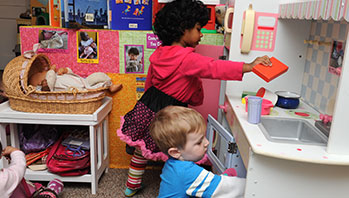- fiction and nonfiction books (families)
- play materials (dress-up clothes and props)
- family
- father
- mom
- sister
MA Standards:
Social Emotional/Family 6.1: Describe different types of families, addressing membership and social influences, and the functions of family members.
Head Start Outcomes:
Approaches to Learning/
Cooperation: Joins in cooperative play with others and invites others to play.
Logic and Reasoning/Symbolic Representation: Engages in pretend play and acts out roles.
PreK Learning Guidelines:
English Language Arts/Language 3: Communicate personal experiences or interests.
Health Education 20: Describe members of their family and discuss what parents do for their children to keep them safe and healthy.
Play Family

© Commonwealth of Massachusetts, Department of Early Education and Care (Jennifer Waddell photographer). All rights reserved.
Have books about families on display as children create a house play area in the Center.
Guide children as they set up the play area. Talk about different members of a family and the role each one plays in the family.
Once the area is set up, explain to children that you want them to pretend to be different members of a family. Encourage them to use props and to talk as if they are the person they are pretending to be.
Prompt children to make connections to their lives and acknowledge behaviors as they pretend. For example, say,
- I like the way you are helping your daughter with her homework. Does your mom help your big sister with her homework the same way you are helping your pretend daughter?
- I notice your father is making dinner tonight. I like to help my father make dinner. Do you help your father make dinner?
- I see you like to read a story to the children before they go to sleep. Do you like having a book read to you before you go to sleep?
